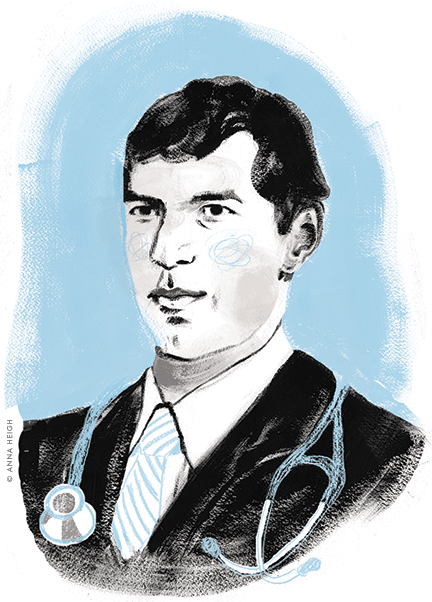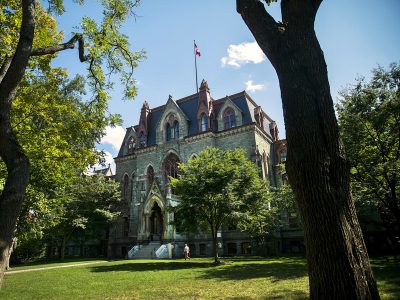
David Fajgenbaum M’13 WG’15 had a tough act to follow at Wharton’s commencement ceremony in May. Warby Parker co-founders Neil Blumenthal WG’10 and David Gilboa WG’10 GEng’10 [“Alumni Profiles,” July|Aug 2012],whose eyewear company was recently valued at more than $1 billion, had just sweetened their keynote address with the promise of free sunglasses for each member of Wharton’s 2015 MBA class.
But Fajgenbaum, who had been chosen to deliver the student address, was the one who spurred his fellow graduates to a raucous standing ovation.
Their wave of love and support reverberated off the Palestra’s walls in a direct echo of Fajgenbaum’s speech. “At Wharton,” he said, “I certainly received the training I needed … but this is what I never expected: Twenty of my classmates would join me on [a] leadership team and contribute over 3,000 hours to our work.
“Turn to your classmates,” he exhorted a few minutes later. “They’ll go to battle with you, just as they’ve gone to battle with me.”
That line was more than a tired metaphor. It referred to the 30-year-old’s literal fight for his life. Fajgenbaum came to Wharton for more than just another advanced degree. (In addition to his medical degree from Penn, he has a master’s in public health from Oxford University.) He wanted to accelerate the search for a cure for Castleman Disease, a rare and potentially deadly autoimmune disease that is diagnosed in an estimated 5,000 to 7,000 Americans each year. One of them is Fajgenbaum, who suffers from a sub-type that affects multiple lymph nodes and can impair multiple organ systems.
Fajbenbaum was a typical third-year medical student, healthy if harried, when he began suffering from recurrent flu-like symptoms in 2010. For three weeks, he experienced night sweats, fatigue, and nausea. He suffered abdominal cramps and his lymph nodes were enlarged. By the time he was admitted to the intensive care unit, his liver and kidneys were shutting down. He stayed for nearly four weeks, temporarily losing vision in one eye. Doctors started him on a high dose of steroids, and eventually declared him in to be in remission—without arriving at a specific diagnosis.
Three weeks after he was released, while recovering at his family home in Raleigh, North Carolina, Fajgenbaum’s symptoms returned in full force. He was diagnosed with idiopathic multi-centric Castleman Disease (iMCD), in which the lymphatic system produces an excess of inflammatory proteins that can cause kidney, nerve, and heart damage, among other things. He was so weakened that his family called in a priest to offer last rites. Yet his doctors ultimately managed to bridle the disease’s progression—with a seven-agent chemotherapy regimen that essentially wiped out his overactive immune system.
It was the start of a cycle of recovery and relapse that’s plagued Fajgenbaum roughly every 15 to 17 months—which has essentially been the time it’s taken his immune system to rejuvenate (and cause more trouble) after successive courses of chemotherapy. When he delivered his Commencement speech in May, he pegged himself as being symptom-free for 16-and-a-half months “and barreling down on the average life expectancy for my disease.”
These days, Fajgenbaum appears lean and strong, his expressive hands large and his frequent grin wide. Sitting at an outside cafe while he briskly summarizes the past five years—“It feels like it’s someone else I’m talking about,” he says—he’s the picture of health: his dark brown hair thick and glinting with a few betraying flecks of grey, his cheeks tinged with pink.
His iPhone’s photo library tells another story. “This is what I looked like at my worst,” he says, landing on an image that shows him hooked to a rolling IV pole, completely bald from chemo, his stomach bloated from fluid retention.
Diagnosis with a life-threatening illness was a perverse twist of fate for Fajgenbaum, a born doctor who says he’s “been on a mission” to fight grave illnesses since his mother, Anne Marie, succumbed to brain cancer when he was a sophomore at Georgetown University.
“Her battle was such a life-changing experience for me,” he says. “It broke my heart—but it made me want to dedicate my life to taking that disease down.”
In the wake of his mother’s death, he helped to co-found National Students of AMF (which stood first for Ailing Mothers and Fathers, then for his mother’s initials, and now, simply, Actively Moving Forward), a peer-led support group for college students grieving the illness or death of a loved one. Since 2006, some 3,000 college students on more than 200 campuses have participated in its discussions and activities.
Despite his early success at managing and growing that network, Fajgenbaum decided he would need a more formal business education when faced with overcoming his own serious disease.
“Once I knuckled down and really starting researching Castleman’s,” he says, “I got a sense of what we all know on some level: that some of the greatest hurdles standing in the way of developing preventions and treatments aren’t medical—they’re business-related. Things like insufficient use of funds, lack of strategy, and limited collaboration. I realized that I had to go to business school to save my life.”
He established the Castleman Disease Collaborative Network (CDCN) in 2012, with the support of former Perelman School of Medicine Dean Arthur Rubenstein.
The network brings together thousands of patients and families with nearly 300 physicians and researchers to act as a repository of shared case studies and research, as well as a catalyst for funding further research, such as the $40,000 that Fajgenbaum’s Wharton classmates recently raised to support research on the genomics of the disease.
Those classmates have also played key roles in guiding the CDCN on fronts ranging from strategic planning to the logistics of tissue-sample collection. “They’ve given over 3,000 hours of manpower last year,” Fajgenbaum says. “That’s literally hundreds of thousands of dollars’ worth of pro bono help from really smart, talented people” who draw from skill sets not always found in the doctors and bench scientists who typically drive biomedical research.
Fajgenbaum has also taken an active role as a researcher. In a 2014 article in the journal Blood, he proposed a model of iMCD’s pathogenesis emphasizing the primary role of inflammatory proteins in causing lymph node enlargement, rather than the other way around. “So instead of chemo,” he explains, “maybe we should be repurposing drugs that act as immune suppressants, like those used by recipients of organ transplants.”
In February 2014, Fajgenbaum started taking a drug whose approved use is for kidney-transplant patients. It essentially quells one arm of the immune system, and may also target a protein that appears to play a role in iMCD. Though he has to be careful about getting colds and other common ailments, he hasn’t slowed down. He began the treatment while he and his then-fiancée, Caitlin Prazenica, were in a swirl of planning for their May ceremony. (“I was so happy to have a full head of hair,” he recalls.) Now, he works “all the time,” he says. “It’s how I cope. If I just sat around, I’d go crazy. That way, if I relapse and I don’t survive, at least I’ll know I did every single thing I could.”
Fajgenbaum says he feels like he’s in “overtime” of a game that “could be finished at any moment.” If he can get to 18 months between relapses, he says, “I will really feel like the research I’ve done has extended the window of being symptom-free.”
The date he’s aiming for is easy to remember. “July 5,” he laughs, throwing his arms in the air. “That’s my independence day.”
—JoAnn Greco





Excellent article. Let’s hope for a cure!!!!!!
So proud to be a friend of yours David, being involved in your fight I have seen your life and trials inspire so many. Best wishes my friend
Keep up the fight!
I am so joyful that someone like David is tackling Castlemans disease. I nearly lost my
life from it in 07, and am exceeding glad to be alive.